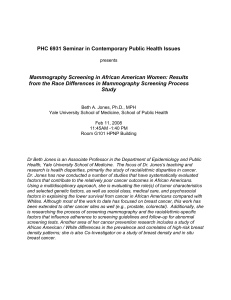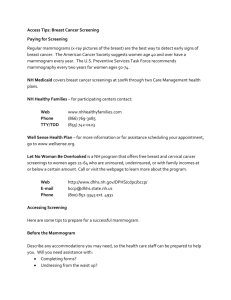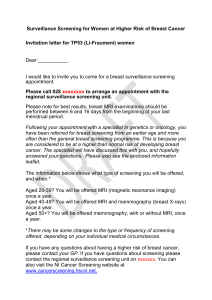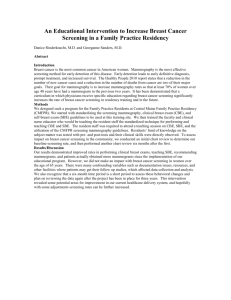Cancer Screening & Diagnostics
advertisement
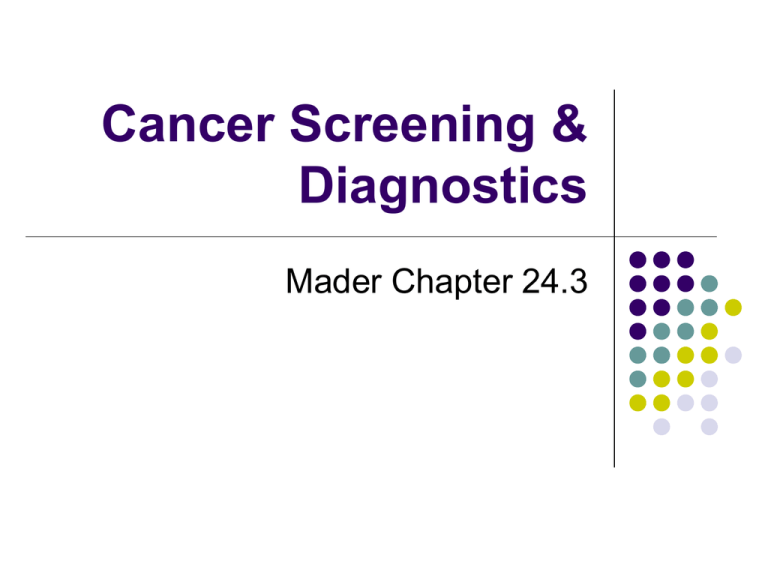
Cancer Screening & Diagnostics Mader Chapter 24.3 Cancer Yearly Morbidity & Mortality by Sex & Site Introduction to Screening Estimates of the premature deaths that could have been avoided through screening vary from 3% to 35%, depending on a variety of assumptions. There are, however, several potential harms that must be considered against any potential benefit of screening for cancer. Although most cancer screening tests are noninvasive or minimally invasive, some involve small risks of serious complications that may be immediate (e.g., perforation with colonoscopy) or delayed (e.g., potential carcinogenesis from radiation). Another harm is the false-positive test result, which may lead to anxiety and unnecessary invasive diagnostic procedures. A less familiar harm is over diagnosis, i.e., the diagnosis of a condition that would not have become clinically significant had it not been detected by screening. This harm is becoming more common as screening tests become more sensitive at detecting tiny tumors. Finally, a false-negative screening test may falsely reassure an individual with subsequent clinical signs or symptoms of cancer and thereby actually delay diagnosis and effective treatment. Screening-Breast Cancer Yearly mammograms are recommended starting at age 40 and continuing for as long as a woman is in good health. Clinical breast exam (CBE) should be part of a periodic health exam, about every 3 years for women in their 20s and 30s and every year for women 40 and over. Women should know how their breasts normally feel and report any breast change promptly to their health care providers. Breast self-exam (BSE) is an option for women starting in their 20s. Women at increased risk (for example, family history, genetic tendency, past breast cancer) should talk with their doctors about the benefits and limitations of starting mammography screening earlier, having additional tests (for example, breast ultrasound or MRI), or having more frequent exams. Radiological detection- Breast cancer Screening- Colon and Rectal Cancer Beginning at age 50, both men and women should follow 1 of these 5 testing schedules: yearly fecal occult blood test (FOBT)* or fecal immunochemical test (FIT) flexible sigmoidoscopy every 5 years yearly FOBT* or FIT, plus flexible sigmoidoscopy every 5 years** double-contrast barium enema every 5 years colonoscopy every 10 years People should talk to their doctor about starting colorectal cancer screening earlier and/or undergoing screening more often if they have colorectal cancer risk factors Screening - Prostate Cancer Both the prostate-specific antigen (PSA) blood test and digital rectal examination (DRE) should be offered annually, beginning at age 50, to men who have at least a 10-year life expectancy. Men at high risk (African-American men and men with a strong family of one or more first-degree relatives [father, brothers] diagnosed before age 65) should begin testing at age 45. Men at even higher risk, due to multiple first-degree relatives affected at an early age, could begin testing at age 40. Depending on the results of this initial test, no further testing might be needed until age 45. Screening - Cervical Cancer All women should begin cervical cancer screening about 3 years after they begin having vaginal intercourse, but no later than when they are 21 years old. Screening should be done every year with the regular Pap test or every 2 years using the newer liquid-based Pap test. Beginning at age 30, women who have had 3 normal Pap test results in a row may get screened every 2 to 3 years. Another reasonable option for women over 30 is to get screened every 3 years (but not more frequently) with either the conventional or liquid-based Pap test, plus the HPV DNA test. Women who have certain risk factors such as diethylstilbestrol (DES) exposure before birth, HIV infection, or a weakened immune system due to organ transplant, chemotherapy, or chronic steroid use should continue to be screened annually. Screening - Endometrial (Uterine) Cancer The American Cancer Society recommends that at the time of menopause, all women should be informed about the risks and symptoms of endometrial cancer, and strongly encouraged to report any unexpected bleeding or spotting to their doctors. For women with or at high risk for hereditary non-polyposis colon cancer (HNPCC), annual screening should be offered for endometrial cancer with endometrial biopsy beginning at age 35. Assessment of Genetic Risk= family history For example, a woman who has a firstdegree relative (mother, sister, or daughter) who has breast cancer has twice the risk of getting breast cancer than a woman who does not have a family history of breast cancer. Or, a woman who tests positive for genetic alterations (called mutations) in the BRCA1 (Breast Cancer 1) gene would have a 55 percent to 85 percent chance of developing breast cancer by age 70. Genetic Testing for Hereditary Cancer Myriad Genetic Laboratories is a leader in cancer predisposition testing. Myriad discovered the BRCA1 and BRCA2 genes that cause hereditary breast and ovarian cancer, and now offers the most accurate clinical tests available to determine predisposition to cancer: BRACAnalysis® for hereditary breast and ovarian cancer, COLARIS® for hereditary colon and endometrial cancer, COLARIS AP® for hereditary colorectal polyps and cancer, and MELARIS® for hereditary melanoma and pancreatic cancer. These tests are unparalleled in accuracy, quality and customer service. ** **This is an advertisement from Myriad not my opinion The value of testing Genetic testing may help you to: Make medical and lifestyle choices. Find out you do not have an altered gene. Cope with your cancer risk. Decide whether to have prophylactic, or preventive, surgery such as prophylactic mastectomy (removal of a breast) or oophorectomy (removal of one or both ovaries). Provide useful information to other family members (if you decide to share your results). Contribute to research. The disadvantages of testing There is no proven way to reduce genetic cancer risk, except through periodic examination and/or surgery. There is no guarantee that test results will remain private. You may face discrimination in health insurance, life insurance, or employment. You may find it harder to cope with your cancer risk knowing the results. Negative results may provide a false sense of security because you think you have no chance of getting cancer, which is not true. Genetic testing requires genetic counseling. It is costly and may not be covered by your insurance. Signs & symptoms Change in bowel habits or bladder function: Chronic constipation, diarrhea, or a change in the size of the stool may indicate colon cancer. Pain with urination, blood in the urine, or a change in bladder function (such as more frequent or less frequent urination) could be related to bladder or prostate cancer. Sores that do not heal: Skin cancers may bleed and resemble sores that do not heal. A persistent sore in the mouth could be an oral cancer and should be dealt with promptly, especially in patients who smoke, chew tobacco, or frequently drink alcohol. Unusual bleeding or discharge: Unusual bleeding can occur in either early or advanced cancer. Blood in the sputum (phlegm) may be a sign of lung cancer. Blood in the stool (or a dark or black stool) could be a sign of colon or rectal cancer. Cancer of the cervix or the endometrium (lining of the uterus) can cause vaginal bleeding. Blood in the urine is a sign of possible bladder or kidney cancer. A bloody discharge from the nipple may be a sign of breast cancer. Thickening or lump in breast or other parts of the body: Many cancers can be felt through the skin, particularly in the breast, testicle, lymph nodes (glands), and the soft tissues of the body. A lump or thickening may be an early or late sign of cancer. You may be feeling a lump that is an early cancer that could be treated successfully. Indigestion or trouble swallowing: While they commonly have other causes, these symptoms may indicate cancer of the esophagus, stomach, or pharynx (throat). Recent change in a wart or mole: Any change in color or shape, loss of definite borders, or an increase in size should be reported to your doctor without delay. The skin lesion may be a melanoma which, if diagnosed early, can be treated successfully. Nagging cough or hoarseness: A cough that does not go away may be a sign of lung cancer. Hoarseness can be a sign of cancer of the larynx (voice box) or thyroid. Physical Diagnosis Melanoma The Gold Standard of Diagnosis - Biopsy The only absolutely certain way to diagnose a cancer is to take a cell sample (a process called a biopsy) and look at it under a microscope. This is usually done by placing a needle into the affected area and sucking out some cells. CT image-directed biopsy. A patient with a large retroperitoneal liposarcoma occupying nearly 75% of the total abdominal and retroperitoneal space. A CT-directed needle biopsy is being performed in an area of suspected liposarcoma dedifferentiation. The posterior approach through the lumbar musculature allowed positive identification of dedifferentiation, which led to initial neoadjuvant therapy prior to an ultimately successful surgical resection. Tumor specific protein staining A. Prostate Cancer Stained for HIP-1 B. Normal Prostate Stained for HIP-1 Staining Breast Cancer for p53 Medullary Cancer Glandular Cancer Unstained Stained with p53 antibody


